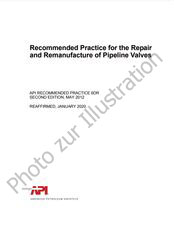Wir benötigen Ihre Einwilligung zur Verwendung der einzelnen Daten, damit Sie unter anderem Informationen zu Ihren Interessen einsehen können. Klicken Sie auf "OK", um Ihre Zustimmung zu erteilen.

API PUBL 4688-ed.1999
Temporary Treatment Options for Petroleum Distribution Terminal Wastewaters
Name übersetzen
NORM herausgegeben am 1.11.1999
Informationen über die Norm:
Bezeichnung normen: API PUBL 4688-ed.1999
Ausgabedatum normen: 1.11.1999
SKU: NS-1139850
Zahl der Seiten: 67
Gewicht ca.: 201 g (0.44 Pfund)
Land: Amerikanische technische Norm
Kategorie: Technische Normen API
Die Annotation des Normtextes API PUBL 4688-ed.1999 :
API PUBL 4688, 1999 Edition, November 1999 - Temporary Treatment Options for Petroleum Distribution Terminal Wastewaters
Purpose of the Document
This document provides guidance to terminal operators and engineers in evaluating and selecting mobile treatment systems for wastewater generated at petroleum distribution terminals.
Why Consider Mobile Treatment?
Three reasons for terminal personnel to consider the use of mobile treatment include:
- • wastewater does not meet final disposal requirements (e.g., NPDES permit limits)
- • wastewater flow is of short duration (less than 3 months per year) and can have significant volume (more than 10,000 gallons)
- • resources (labor, time, and capital budget) are limited
Mobile treatment systems may not be appropriate for all wastewater streams at a petroleum terminal. In some cases, transportation to an off-site treatment facility or construction of a permanent treatment system is a better choice.
When to Use Mobile Treatment (Comparison to Other Alternatives)
As indicated on Table 1-1 , mobile treatment systems have distinct advantages over other alternatives. Mobile treatment is often more appropriate than on-site permanent treatment or transportation off-site. First of all, mobile treatment requires little or no capital improvements to implement. Treatment can begin rapidly because the mobilization and installation are so quick. Mobile treatment technologies are flexible so that they can be easily moved from site to site to treat flows that occur over a short time period. In addition, the labor and expertise to install and operate a mobile system are supplied by the contractor - a critical consideration when the terminals resources are limited.
There are some limits, however, to using mobile treatment. Even though capital costs are generally small (e.g., utility hookup), long-term operating costs, and the costs of mobilization and demobilization, should be considered. Residual disposal and treatment costs will also increase the operation and maintenance cost. Another disadvantage of mobile treatment is the liability incurred by having contractor personnel and equipment on site for a period of time.
Another drawback is the required time to manage the contractor (e.g., initial negotiations, setup, and oversight).
When considering the use of mobile treatment, weigh the benefits and drawbacks of mobile treatment in relation to the other two alternatives on Table 1-1. The specific characteristics of the terminal (wastewater and location) will affect selection of the most appropriate alternative for the petroleum terminal. In general, mobile treatment should be used if there is a large volume (>10,000 gallons) of wastewater and flow is periodic and of short duration. On the other hand, permanent treatment should be implemented if the wastewater stream is continuous and the flow rate is relatively large. As a rule of thumb, off-site treatment should be used if the wastewater volume is small (<10,000 gallons) and flow is periodic.
Document Overview
This document addresses the four-step process for evaluating and selecting a mobile treatment system and contractor. Section 2.0 summarizes the problem definition process that includes characterization of the wastewater and identification of permitting and site constraints. Section 3.0 summarizes the treatment technology selection process. Section 4.0 describes the contractor selection process. Sections 5.0 and 6.0 summarize the implementation issues to consider prior to project initiation.
Empfehlungen:
Aktualisierung der technischen Normen
Wollen Sie sich sicher sein, dass Sie nur die gültigen technischen Normen verwenden?
Wir bieten Ihnen eine Lösung, die Ihnen eine Monatsübersicht über die Aktualität der von Ihnen angewandten Normen sicher stellt.
Brauchen Sie mehr Informationen? Sehen Sie sich diese Seite an.



 Cookies
Cookies
